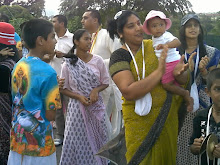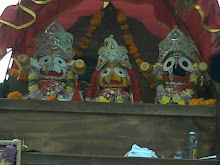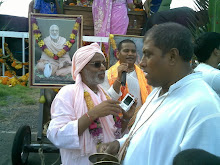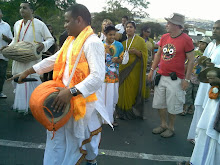HomeMissionAbout UsBhakti is LoveSacred PlacesTeachersBhaktiYogaMastersBhaktiYogaTeachersBhakti DiscoursesSrila GurudevaResourcesAudio & VideoeBooks & MagazinesHarmonist MonthlyKirtansLinksPhoto GalleryPurchase BooksSearchSite MapTraveling to IndiaVaisnava CalendarEventsBhakti NewsTour ReportsUpcoming EventsContact UsCentersTeachersWebsite ContactsHome Teachers Bhakti Discourses 2004 Purusottama Month in Puri
Purusottama Month in Puri
Wednesday, 04 August 2004
Sri Sri Radha-PurusottamaJagannatha Puri, India: August 4, 2004
Tridandisvami Sri Srimad Bhaktivedanta Narayana Maharaja
[Under the guidance of Srila Bhaktivedanta Narayana Maharaja, the month-long Kartika parikrama, inauguration of the newly built Sri Sri Giridhari Gaudiya Matha, and installation of Sri Sri Radha-Vinodabihariji, Sri Caitanya Mahaprabhu and the divine murti of Srila Bhaktiprajnana Kesava Gosvami Maharaja was successfully performed. Please excuse us that, due to the art marathon taking place throughout the parikrama, we were not able to send out many lectures. By the mercy of Sri Sri Guru and Gauranga we can now begin the process of transcribing and editing those lectures, and soon you will be receiving them. In the meantime, please accept the first of the lectures given by Srila Narayana Maharaja during the previous parikrama, in Jagannatha Puri:]
Srila Maharaja speaking in Puri{Every evening, when the devotees returned from the day’s Jagannatha Puri parikrama, Srila Maharaja spoke at the Sri Krsna-Caitanya Gaudiya Matha. This temple is the home of Sri Sri Radha Nayana-mani and Sri Jagannatha, Baladeva and Subhadraji, as well as the holy birth place of Sri Srimad Bhaktsiddhanta Saraswati Thakura Prabhupada. It is located on the same road as the famous Sri Jagannatha Mandira and is only a five-minute walk from there. The acarya of the temple is Srila Bhakti Dayita Madhava Gosvami Maharaja, a prominent disciple of Sri Srimad Bhaktisiddhanta Saraswati Thakura. (About 700 devotees from all over the world were in attendance for Srila Narayana Maharaja’s lectures. Many of the parikrama pilgrims were living in the guesthouse of that temple, and others had rooms in nearby hotels.)
The following was Srila Narayana Maharaja’s introductory lecture wherein he welcomed all the international pilgrims and explained to them the significance of their being in Puri at that sacred time.}
I offer pranama to the lotus feet of my guru-padapadma, nitya-lila pravistha om visnupada Sri Srimad Bhaktiprajnana Kesava Gosvami Maharaja, and also to my siksa-guru, Paramapujyapada nitya-lila pravistha om visnupada Sri Bhakti Dayita Madhava Gosvami Maharaja, who established this temple.
We are all very supremely fortunate to have come here to Purusottama-ksetra Jagannatha Puri-dhama, and stay so close to Purusottama-deva Sri Jagannatha Himself. We are especially fortunate to be here in this month called Purusottama-masa and to perform Purusottama-vrata (the auspicious vows taken on this month). We are even more fortunate to have the shelter of this particular place – the divine appearance place of nitya-lila pravistha om visnupada Sri Srimad Srila Bhaktisiddhanta Sarasvati Thakura Prabhupada and the bhajana kutira of Srila Bhaktivinoda Thakura.
In chapter fifteen of Bhagavad-gita, Lord Krsna describes three types of personalities: ksarah, aksarah and purusottama. Ksarah means fallible, and it refers to those living entities who have forgotten Krsna. By constitution, all living entities are the eternal servants of Krsna. Those living entities who are bereft of the knowledge of their own spiritual identity and nature, and whose nature is now hidden by the material energy, are called ksarah-purusa. They are called fallible living entities or conditioned souls.
There is another type of living entity and Lord Krsna calls them aksarah, infallible. They are the liberated souls. They are fully aware of their identity as His eternal servants.
After describing the ksarah-purusa and aksarah-purusa, Krsna explains that above both categories of souls is the Supermost Personality. He is superior to all the living beings and is therefore called Purusottama, the Supreme Person. Sri Krsna says, “I am that Purusottama, the Supreme Personality of Godhead.”
Purusottama month comes in the leap year – every thirty-two months. Previously this month was known as mala-masa. Mala means unclean, contaminated and suitable for being rejected. This was considered the “rejectable” month, because about it sastra says: “You should not perform any ritualistic activities, such as getting married or receiving sacred thread according to the principles of varnasrama-dharma.” All of these materially auspicious activities are stopped during this month. No one is permitted to perform any of them, and so this month was known as Mala-masa, the contaminated month. The personification of this month approached Sri Krsna and said to Him: “Oh my Lord, all despise me and condemn me in this world, because they cannot perform any auspicious fruitive activities in my presence. I take complete shelter of You and surrender to you. What should I do?”
Krsna explains in the Gita:
sarva dharman parityajya
mam ekam saranam vraja
aham tvam sarva-papebhyo
moksayisyami ma sucah
[“Abandon all varieties of religion and just surrender unto Me. I shall deliver you from all sinful reactions. Do not fear.” Bhagavad-gita 18.66)]
Give up all types of material religiosity and surrender to Me unconditionally. I will take away all reactions to your sinful activities; do not fear. Lord Krsna replied to Mala-masa, “I will take away all your contamination, because you are surrendered unto Me. I myself will become the predominating deity of this month. From now on the people will not call you Mala-masa. Instead they will call you Purusottama-masa. During this month they will observe Purusottama-vrata, the very auspicious activities of devotional service in Purusottama-ksetra.”
This month should be observed by following the rules and regulations one follows during Kartika month. Srimati Radhika is the predominating deity in the month of Kartika, and Krsna is the predominating deity of Purusottama-masa.
One should not perform any material pious activities (subha-karma) in this month. Instead of being derailed into material activities, one should become one-pointed and do one-pointed vows – for the happiness of Krsna. Only perform service to Hari-Guru and Vaisnavas, chant harinama and stay near Purusottama-deva. For those who observe this vow, it is certain that all their desires will be fulfilled. All so-called auspicious activities of this world, such as performing duties within varnasrama-dharma and getting married, will have no value if one does not perform bhajana and if Lord Krsna is not pleased. Therefore, all the devotees who have assembled here to observe Purustottama-vrata in Purusottama-ksetra, at the birthplace of Srila Bhaktisiddhanta Sarasvati Thakura, are supremely fortunate.
Those who reside in foreign countries such as Holland and here and there, but whose ancestors are originally from India, are allowed to enter Sri Jagannatha Mandira and Sri Gundica Mandira. For others, Jagannatha-deva is causelessly merciful. Every year during the Ratha-yatra festival He comes to the Gundica temple and all can see Him. I request you to follow the principles of Srila Haridasa Thakura, Srila Sanatana Gosvami and Srila Rupa Gosvami. Srila Haridasa Thakura never tried to enter the Jagannatha temple, but at the time of the car festival no one could check him. He used to dance here and there with Sri Caitanya Mahaprabhu. So you are also very fortunate; you can follow in that way.
All the devotees should come here for mangala-arati. After mangala-arati all devotees can sit down and sing kirtana, as we do during Kartika-vrata. Then there can be a short class, and at 6.30 all devotees should leave for parikrama. We will then go to Sri Gambira and Radha-kanta Matha, and from there we will go to Siddha-bhakula, the place of Srila Haridasa Thakura. We will then go to Svargadvara and the house of Srila Sarvabhauma Bhattacarya, and after that all the devotees will go to the Jagannatha Mandira. Those who have taken birth in Western countries, who are not of Indian ancestry, should not try to enter the Jagannatha temple. They should stay outside and take darsana of Patita-pavana Jagannatha outside.
Today is the day before we begin our parikrama, and during this parikrama I will explain Raya Ramananda Samvad. As an introduction to Raya Ramananda Samvad, you will need to hear an explanation of how Sri Caitanya Mahaprabhu first heard about Raya Ramananda from Sri Sarvabhauma Bhattacarya.
Sri Sarvabhauma Bhattacarya was living here in Jagannatha Puri, and he was teaching and following the Advaita Vedanta of Sankaracarya. He was so learned, such a great philosopher and so influential that great sannyasis would come to him. They would even receive from him saffron cloth again, as well as the sannyasa reformatory process again. They would thus receive what was considered by the mayavadis to be a more elevated sannyasa community or sampradaya. When Sri Caitanya Mahaprabhu met with him He had respect for him, but He was of a completely different opinion regarding philosophical conclusions.
Sri Sarvabhauma Bhattacarya wanted to teach Advaita Vedanta to Sri Caitanya Mahaprabhu, so he began to explain the theory of Sankaracarya and his explanation of all the sutras of Vedanta. He explained that the Absolute Truth is indescribable, beyond the description of words – because it is impersonal.
Sri Caitanya Mahaprabhu was sitting before Sarvabhauma Bhattacarya as he explained his philosophy, all day and night for seven days in a row. Sarvabhauma Bhattacharya was struck with wonder because Sri Caitanya Mahaprabhu didn’t move, He didn’t ask a question, and there was no expression on His face. Therefore, it wasn’t clear to him whether or not Sri Caitanya Mahaprabhu could understand his explanation. He asked, “Do you understand my explanation or not?”
Previous to this, Gopinatha Acarya had spoken with him and tried to convince him that Sri Caitanya Mahaprabhu is the Supreme Personality of Godhead. Gopinatha Acarya was his brother-in-law and he knew that Sri Caitanya Mahaprabhu was that original Supreme Person, Krsna Himself, adorned with the sentiments and complexion of Srimati Radhika.
Although Sarvabhauma Bhattacarya was very learned and an incarnation of the demigod Brhaspati (chief priest of the heavenly kingdom and spiritual master of the demigods headed by King Indra), he could not understand the advice and explanations of Gopinatha Acarya. The Bhattacarya had explained to Sri Caitanya Mahaprabhu that God has no form, no qualities and no pastimes. Sri Caitanya Mahaprabhu replied, “O Sarvabhauma Bhattacarya, the sutras (verses containing volumes of meaning) of Vedanta are self-effulgent and self-evident like the sun, but your explanation is just like a black cloud covering the sun.” “My dear sir, I can understand the meaning of the sutras like janmady asya yatah , sastra-yonitvat, and athato brahma jijïasa of the Vedanta-sutra, but when you explain them in your own way it becomes difficult for Me to follow them. The purpose of the sutras is already explained in them, but your explanations are covering them with something else. You do not purposely take the direct meaning of the sutras but indirectly give your own interpretations.” When Sarvabhauma Bhattacarya heard this, he said: “Until today, no one has been able to refute my commentaries; so I want to hear your explanation.” Sri Caitanya Mahaprabhu then began to explain all the Vedanta-sutras of Vedanta. First of all:
janmady asya yato 'nvayad itaratas carthesv abhijnah svarat
tene brahma hrda ya adi-kavaye muhyanti yat surayah
tejo-vari-mrdam yatha vinimayo yatra tri-sargo 'mrsa
dhamna svena sada nirasta-kuhakam satyam param dhimahi
”O my Lord, Sri Krsna, son of Vasudeva, O all-pervading Personality of Godhead, I offer my respectful obeisances unto You. I meditate upon Lord Sri Krsna because He is the Absolute Truth and the primeval cause of all causes of the creation, sustenance and destruction of the manifested universes. He is directly and indirectly conscious of all manifestations, and He is independent because there is no other cause beyond Him. It is He only who first imparted the Vedic knowledge unto the heart of Brahmaji, the original living being. By Him even the great sages and demigods are placed into illusion, as one is bewildered by the illusory representations of water seen in fire, or land seen on water. Only because of Him do the material universes, temporarily manifested by the reactions of the three modes of nature, appear factual, although they are unreal. I therefore meditate upon Him, Lord Sri Krsna, who is eternally existent in the transcendental abode, which is forever free from the illusory representations of the material world. I meditate upon Him, for He is the Absolute Truth. (Srimad Bhagavatam) 1.1.1)”
Brahma (the Supreme Spirit) is that from which everything is emanated. Sriman Mahaprabhu gave evidence from the Vedas: ‘yato va imani bhutani.’ Everything has emanated from Brahma, everything is resting in Brahma and everything enters into Brahma. How can it be that the source of all forms and personalities has no form or personality? This is not possible. God is sat-cit-ananda vigraha, He has a form of eternity, knowledge and bliss, as explained in Vedanta-sutra.
Arupa-vat eva hi tat pradhanatvat. This is one of the sutras (verses full with meaning) of Vedanta-Sutra. Arupavat means "apparently without a form." "Rupa” means “form”, “a” means “not” and “vat” means “like”, or “in comparison”. This word, therefore, also means “it is not like the form.” The suffix “vat”, meaning “like” or “in comparison”, is also used in the word "naravat-lila, meaning Sri Krsna’s human-like pastimes. His pastimes appear LIKE those of a human being, but they are not those of a human. “Nara” means “human”, and Krsna’s pastimes (lila) are described as “naravat” meaning “like those of a human”. So the meaning of arupa-vat is: “It is not that God’s form as the Deity is LIKE Him. Rather it IS Him. He IS that very form. The arca-vigraha (Deity in the temple) is not a symbolic representation. It is directly Vrajandra-nandana Syamasundara Himself. By the process of worshipping that Deity, one can directly see Him. I may say “the painting of me is like my form”, but this is not the case with Lord Krsna.
Arupa-vat. It is not that God has no form. His Deity (vigraha) is not a symbolic representation of Him. The Deity is directly God Himself. Mahaprabhu explained from the Vedas, “He has no hands, but He accepts offerings.” This means He has no material hands; He has a transcendental form. Sriman Mahaprabhu also explained from Srimad Bhagavatam:
atmaramas ca munayo
nirgrantha apy urukrame
kurvanty ahaitukim bhaktim
ittham-bhuta-guno harih
[“All different varieties of atmaramas [those who take pleasure in atma, or spirit self], especially those established on the path of self-realization, though freed from all kinds of material bondage, desire to render unalloyed devotional service unto the Personality of Godhead. This means that the Lord possesses transcendental qualities and therefore can attract everyone, including liberated souls.” (Srimad Bhagavatam 1.7.10)]
‘Ittham-bhuta-guno harih’ means that God has so many wonderful qualities. ‘Nirgrantha’ means those personalities who are completely liberated from this material world, like the four Kumaras (Sanaka, Sanandana, Sanatana and Sanat-kumara), Srila Sukadeva Gosvami and others. Though previously absorbed in nirvisesa-brahma, when they heard about the qualities of Sri Krsna, they became attracted, because His qualities are transcendental. They are abheda, non-different from Him.
Explaining the verses in this way Sri Caitanya Mahaprabhu defeated all the explanations of Sarvabhauma Bhattacharya and established the actual philosophical conclusions.
He then allowed Sarvabhauma Bhattacarya to see His Sad-bhuja rupa – His six-armed form. This six-armed form has two bluish arms of Krsna holding a flute, two greenish arms of Ramacandra holding a bow in one hand and an arrow in another, and two arms of Sri Caitanya Mahaprabhu holding a danda in one hand and a water pot in the other. In this way, Sarvabhauma Bhattacarya was completely transformed.
Sarvabhauma Bhattacarya previously taught ‘sarvam hy etad brahma’, meaning‘everything is ultimately impersonal Brahma.’ One should perform pancha upasana: the worship of Durga, Suryadeva, Ganesha, Siva and Visnu, but actually, everything is that impersonal Spirit. He had been teaching this, but after his meeting with Sri Caitanya Mahaprabhu he became completely transformed.
The next morning Sri Caitanya Mahaprabhu gave him some prasadam, and he immediately accepted it without taking bath or performing any morning duties. The Bhattacarya then gave evidence from the injunction of Vedic scriptures. In the scriptures it is stated: “Whether you are pure or not, you should take mahaprasadam immediately, even if it has fallen from the mouth of a dog.” In this way we can see how Sri Caitanya Mahaprabhu transformed his personality.
One day, Sarvabhauma Bhattacharya quoted a verse from Srimad Bhagavatam:
tat te ’nukampam susamiksamano
bhunjana evatma-krtam vipakam
hrd-vag-vapurbhir vidadhan namas te
jiveta yo mukti-pade sa daya-bhak
[“My dear Lord, one who earnestly waits for You to bestow Your causeless mercy upon him, all the while patiently suffering the reactions of his past misdeeds and offering You respectful obeisances with his heart, words and body, is surely eligible for liberation, for it has become his rightful claim.”(Srimad Bhagavatam 10.14.8)]
This verse says, ‘mukti-pade sa’, but he changed it to ‘bhakti-pade sa’. Now that his personality had been changed so greatly, he could not bare to hear the word, ‘mukti-pade’. He was thinking, “Those who tolerate all the difficulties and problems of life, thinking that the difficulties are coming as the fruits of their own karma, those who thus engage their body, mind and words in praying to the Supreme Lord – will get mukti?” He did not like this, so he changed the verse to ‘bhakti-pade sa daya-bhak’.
Sri Caitanya Mahaprabhu told him, “There is no fault in Srimad Bhagavatam; you should not change the verse. ‘Mukti-pade’ is perfect.” It refers to the Supreme Personality of Godhead, whose lotus feet are served by those living entities who are completely liberated from this world. Srimad Bhagavatam gives the correct conclusion – that those who are addicted to the transcendental service of the Supreme Lord, even if they are offered liberation, will not accept it.
Thus, while living in Jagannatha Puri, Sri Sarvabhauma Bhattacarya was completely transformed into a pure Vaisnava by the mercy of Sri Caitanya Mahaprabhu. It is from Sarvabhauma Bhattacarya that Sri Caitanya Mahaprabhu first heard about Sri Raya Ramananda, after which He decided to search for him and have his association.
Tomorrow I will explain how Sri Caitanya Mahaprabhu met with Raya Ramananda, and what subject matter they discussed.
--
< Prev Next >
Last Updated on Monday, 26 April 2010
Subscribe to:
Post Comments (Atom)










-001.jpg)
-001.jpg)
-001.jpg)
-001.jpg)

-001.jpg)
-001.jpg)


No comments:
Post a Comment